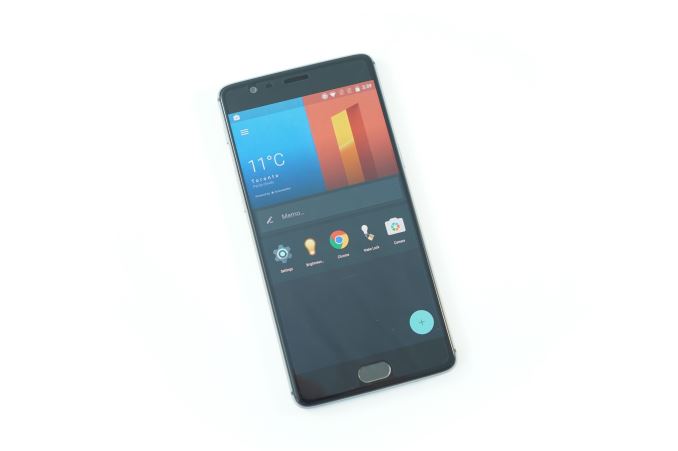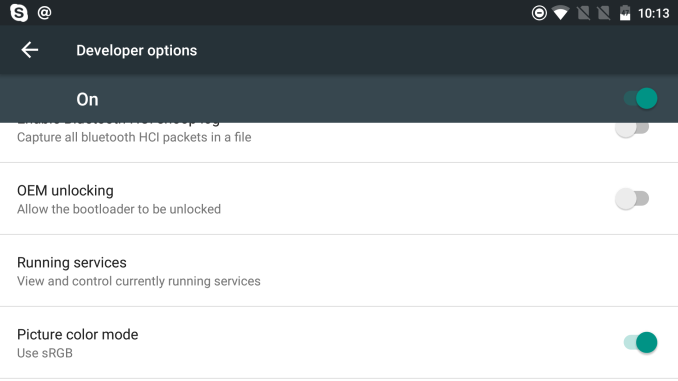Revisiting The OnePlus 3: sRGB, Memory Management, & More
by Brandon Chester on June 30, 2016 3:00 PM EST- Posted in
- Smartphones
- OnePlus
- OnePlus 3

Last week I published my review of the OnePlus 3. I reviewed the OnePlus 2 for AnandTech, and given that the OnePlus 2 had many problems it seemed appropriate that I should examine the improvements that OnePlus made with their latest smartphone. As I used the phone, I was glad to see that OnePlus had clearly taken feedback from the reviews of the OnePlus 2 to heart and spent the year since then working on creating a truly great phone. From the chassis, to the camera, to the SoC, the OnePlus 3 really delivered a level of quality comparable to phones that cost significantly more.
There was one exception to this trend, which was the OnePlus 3's display. The OnePlus One shipped with a 5.5" 1080p IPS display, and it clearly aimed to accurately render content targeting the sRGB color space, which applies to essentially all content that you'll see on a smartphone. With the OnePlus 2 things weren't so great. OnePlus still used a 5.5" 1080p IPS display, but there was essentially no effort put into calibrating the display. As for the OnePlus 3, it marked a shift from IPS LCD displays to AMOLED displays in OnePlus's flagship smartphones, and this was to be expected based on the launch of the OnePlus X which sports a 5" 1080p AMOLED display.
The move to AMOLED doesn't come with any inherent issues, but there are things that a manufacturer needs to keep in mind. Without any sort of brightness boost mode the display can be more difficult to use outdoors than competing LCDs, due to AMOLED displays typically capping at 300-400 nits when setting brightness manually. Sharpness is also another factor to consider. The use of the PenTile subpixel arrangement reduces effective resolution, especially when rendering areas of solid color. It also has a negative impact on the rendition of text and other glyphs, as you're not dealing with subpixels aligned in a perfect grid of vertical and horizontal lines. This is why I've advocated for remaining at 1080p when using standard RGB displays but moving to 1440p for PenTile displays. In fact, the red/blue resolution on a 1440p PenTile display is still slightly lower than that of a 1080p RGB display, but that's another topic.
The last thing vendors need to keep in mind about AMOLED displays is that, while they can offer a much greater color gamut than your typical WLED-backlit LCD, without color management this will cause distortions in all content you view on the display. For this reason it's important to offer an sRGB color mode which constrains the display so that it matches the color standard used by essentially all content. Unfortunately, the OnePlus 3 omitted such a feature, which is why it ended up performing so poorly in my display testing.
The display section of my review spawned a great deal of debate, and I'll get into that more on the next page. To sum things up, OnePlus was quickly able to ship a preliminary update to review units which added an sRGB mode in the phone's developer settings. Right now this setting resets upon a reboot, but OnePlus says that it will keep its state between reboots when the stable firmware goes out to all devices. With OnePlus making an effort to correct what I felt was the biggest issue with the OnePlus 3, I thought it only made sense to revisit the display and run it through the tests again to see just what sort of changes have been made, and whether they improve the OnePlus 3's standing among smartphones.
A quick word on memory management:
Before discussing the changes that OnePlus has made to the display, I did want to comment on one of the other controversial aspects about the OnePlus 3. I only mentioned this once in my review, but the OnePlus 3's memory management on its original firmware is quite aggressive about evicting apps from memory, which led many people to wonder why OnePlus had included 6GB of RAM if you couldn't use it. With the beta update that they've sent to review units one of the patch notes states that this behavior has been tweaked somewhat. While I'm not able to do any in-depth comparisons due to the fact that I'm now stuck on this firmware, I did want to mention that app eviction seems to be less aggressive. In my admittedly not very scientific testing I was able to have Chrome with three tabs loaded, Twitter, Hangouts, Dropbox, Google Drive, Gmail, Skype, the Files app, and Google Photos all resident in memory at the same time, and none had to recreate their activities upon me returning to them. Pushing any further would honestly be going far outside the set of apps that I use on a daily basis and can keep track of in my mind, and so at least in my view I don't think app eviction is something to worry about on the OnePlus 3 as of this new firmware.
With that out of the way, lets take a look at the new sRGB mode that has been added to the OnePlus 3.











81 Comments
View All Comments
zepi - Thursday, June 30, 2016 - link
The question is: Is there any real need for device specific calibration if they can just ship a updated colour profile and hit well within "good enough" territory without worrying about device level differences?I wonder if someone could test 20 "identical" OLED phones and 20 identical LCD phones / displays and see if there are any real variations?
Brandon Chester - Thursday, June 30, 2016 - link
I sure wish that we could, but getting more than one device is already very difficult, let alone twenty.It's also worth noting that backlight variance probably makes post-ship changes more difficult on LCDs than on OLEDs.
JanSolo242 - Thursday, June 30, 2016 - link
It would be interesting to know what impact the memory management changes have on battery life, if any.jjj - Thursday, June 30, 2016 - link
Maybe you should have loaded a couple of big games too.Memory management seems to be all over the place and people care about it so including details on it in reviews might not be a bad idea.Would also like to make a case for a 360 Mobile N4 review. Not that i expect you guys to review such a device since you are too commercial to review what's interesting instead of what's in the financial interest of the owner.
Still, you got a 135$ device with 2xA72@ 2.1GHz and 8 more little cores pedaling behind , 4GB of RAM, a GPU that seems sufficient for 1080p gaming ( once again AT really needs to start testing the GPU in actual games at some point this century) and it makes one wonder how much sense does it make to pay 2 to 5 times more on a SD820 device.Sure you get better cam and wifi and other little bits but for a few years midrange was little cores and there was a huge theoretical perf gap.Theoretical because even A53 at high clocks results in a decent experience. Helio X20 and even SD65X changed the landscape in a substantial way and no publication seems to be willing to notice and take a look at that.
Yesumanu - Thursday, June 30, 2016 - link
I would refrain from calling Anand "too commercial" when they're reviewing niche devices like this:http://www.anandtech.com/show/9868/cubot-h1-smartp...
To comment on the phone you have mentioned, it does not have a stellar price/performance ratio. It costs $135 in China, if you're an international buyer be ready to pay $200 for it, and for that price you are better off with the Meizu Note 3 with Snapdragon 652, metal chassis and software support (this "360" company update record is either sketchy or non-existent).
Also, I don't really see the point of testing individual games. We don't care how well certain games are optimized for certain chipsets, Anand just tests the absolute performance of a phone (or relative to its resolution). I suspect that many readers, including me, don't play XYZ or ZYX game on their phone or any at all but want to know if their phone's gpu performance is gimped and may hinder the device's ability to playback videos.
It should also be mentioned that if you go with Mediatek chipsets, you can forget about any custom rom support or even a TWRP-like recovery. For many people that is a deal breaker and personally, I would never buy a phone with Mediatek SoC, altough I know that some people may not share this belief.
Yesumanu - Thursday, June 30, 2016 - link
*Redmi Note 3, not Meizudeyannn - Thursday, June 30, 2016 - link
Whilst I agree with most of this post I have to disagree on some points - especially on the Custom rom and TWRP-like recovery.All Mediatek devices I've used and configured so far have custom rom support albeit lackluster. And I'm talking about a multitude of Mediatek devices I've used or configured for friends from manifacturers like Lenovo, Jayiu, Xiaomi, Doogee, Umi, etc.
The code base is a nightmare when the source code is released at all and when no sources are released naturally you can't find support in places like XDA and have to go look elsewhere and there is a separate set of web pages for custom roms and modified roms for such devices (the 4pda Russian forum for example). But then again this is the case with these manufacturers even when the device has a Snapdragon SOC.
I do have to say the Xiaomi Redmi Note 2 case with unlocked bootloader and sources you can work with for the Helio X10 is the exception and not the rule and yet after mingling with Mediatek devices for some time I decided to move back to using a dev-friendly device like a Nexus or Oneplus One and the Oneplus Three so far feels pretty great.
But indeed it's as easy to revive a softbricked Mediatek devices as it is to revive a Oneplus One just relying on Snapdragon drivers, flash tool and nand flashing. In fact often the custom roms for Mediatek devices came in this fashion and once a TWRP is compiled for the SOC it becomes a base to be used for all other devices with the same SOC revision.
WoodyPWX - Thursday, June 30, 2016 - link
Very good job! Both Brandon and OnePlus! Thanks for the updatemortimerr - Thursday, June 30, 2016 - link
I love the image of an engineer at 1+, who had a working sRGB mode before launch, because they new damn well the thing was shipping attuned to the incorrect mode and knew it would be so bad that it would almost certainly come in handy.MrCommunistGen - Thursday, June 30, 2016 - link
Brandon,I always find it helpful if significant updates like these are mentioned and linked back to in the original review as an update, either on the first page, or in the conclusion.
Of course regular readers like me will see all of the articles as they come out, but we're not the only ones who matter. Someone searching the internet for reviews of a particular device will likely only see the main review and I think it is especially important for those people to know that the reviewer's opinion of the device has changed.
I don't want to rustle any feathers, but when requested, Ganesh did this for his Skylake NUC article: http://www.anandtech.com/show/10327/intel-releases...